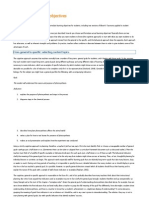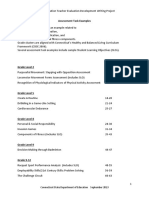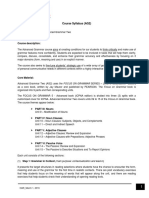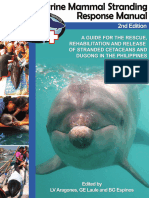Coulon Objective Sheet
Coulon Objective Sheet
Uploaded by
api-239033587Copyright:
Available Formats
Coulon Objective Sheet
Coulon Objective Sheet
Uploaded by
api-239033587Original Title
Copyright
Available Formats
Share this document
Did you find this document useful?
Is this content inappropriate?
Copyright:
Available Formats
Coulon Objective Sheet
Coulon Objective Sheet
Uploaded by
api-239033587Copyright:
Available Formats
PHED 2-LAB #2- Spring, 2009
Laboratory Experience #2
Writing Objectives Purpose: The purpose of this laboratory experience is to provide students practice in writing performance objectives and completing page one of the lesson plan format. The teacher will: learn at least five students names during the class. establish a positive learning environment. provide ample practice time so each student understands how to write a performance objective.
Teacher Goals: 1. 2. 3.
Performance Objectives: The students will: 1. write performance objectives in each of the three learning domains. 2. identify the four components of a performance objective and use each component in an objective. 3. complete page one of a lesson plan format that will be used during Laboratory #3. Format: The first part of lab will provide the students with an example of an effective lesson. The students will learn the four (4) components of a performance objective during the second half of the lab. They will practice writing objectives as a group, then with a partner. They will also practice completing the first page of the standard lesson plan form. Each student will complete the attached worksheet on the writing of performance objectives. This worksheet will be handed in at the beginning of Laboratory #3
Assignment:
PHED 2-LAB #2- Spring, 2009 GUIDELINES FOR WRITING PERFORMANCE OBJECTIVES
Performance objectives give direction to teaching and learning. These objectives describe in clear terms the purpose of the lesson. Since teaching is directed at student learning, these purposes are stated in terms of how students should be able to behave upon completion of the lesson, and are known as performance or behavioral objectives. Performance objectives must describe the behavior of the learner. The key to writing an objective is to identify the appropriate action verb. An action verb describes an observable behavior of the student (see attached list). For example: Practice catching Design a pattern of pathways Follow the class rules The second component of a performance objective is that it must indicate the object of the behavior. This is the content, or subject matter. One can not behave without performing, naming or describing something. This something is the content taught in the lesson. For example: Practice (behavior) catching (content). Design (behavior) a pattern of pathways (content). Follow (behavior) the class rules (content). The third component of a performance objective should state the criteria or standard of performance to be met by the learner. The criteria or standard may be quantitative (how many) or qualitative (how well). For example: Practice (behavior) catching (content) using the fingertips each time (criteria). Design (behavior) a pattern of locomotor movements (content) using three (criteria) Follow (behavior) the class rules (content) without getting a warning (criteria). The final component of a performance objective is the CONDITION under which the behavior is to be performed. The condition describes in what instructional environment the behavior and content will be performed. For example: Practice (behavior) catching (content) using the fingertips each time (criteria) IN SELF SPACE WITH AN ASSORTMENT OF EQUIPMENT (condition). Design (behavior) a pattern of movements (content) by combining three (criteria) DIFFERENT PATHWAYS WITH DIFFERENT LOCOMOTOR MOVEMENTS (condition). Follow (behavior) the class rules (content) without getting a warning (criteria) DURING THE ENTIRE CLASS PERIOD (condition).
All teaching must start with a performance objective. All subsequent decisions about the lesson are based on achieving the stated objective.
WRITING PERFORMANCE OBJECTIVES
PHED 2-LAB #2- Spring, 2009
Listed below are appropriate (observable) and not appropriate (non-observable) action verbs. The verbs are divided into the three learning domains - cognitive (learning and application of knowledge), psychomotor (learning of physical or motor skills), and affective, (concerned with interests, attitudes and values). This list was compiled from Harrison, J.M. and Blakemore, C.L. (1992). Instructional Strategies for Secondary Physical Education. William C. Brown Company, Dubuque, IA. ALL DOMAINS (NOT APPROPRIATE AND NON-OBSERVABLE) - DO NOT USE! COMPREHEND APPRECIATE HAS KNOWLEDGE OF UNDERSTAND THINK HAS AN INTEREST IN LEARN GRASP RESPECT
SPECIFIC TERMS FOR WRITING PERFORMANCE OBJECTIVES COGNITIVE DOMAIN MATCH COMPARE COMPOSE CREATE NAME CLASSIFY CONSTRUCT PRODUCE LIST CONTRAST WRITE DEFINE LABEL RANK ASSEMBLE IDENTIFY PARAPHRASE SOLVE INVENT ORGANIZE DIAGRAM CATEGORIZE MAKE EXPLAIN AFFECTIVE DOMAIN SELECT BE AWARE OF BE CONSCIOUS OF INVOLVE OTHERS TOLERATE COMPLY SYMPATHIZE WITH ACCEPTS RESPONSIBILITY PSYCHOMOTOR DOMAIN DEMONSTRATE COORDINATE PERFORM RHYTHMICALLY PRACTICE EXPLORE EMPLOY INTERPRET APPLY PERFORM UTILIZE DISCOVER LISTEN FOLLOW VOLUNTEER DISCUSS SUMMARIZE ANALYZE PLAN EVALUATE DESIGN ARRANGE BUILD
PHED 2-LAB #2- Spring, 2009
Name:_______________________________
Laboratory Day:________________
Laboratory #2 Worksheet Place the letter of the correct part of the performance objective next to the number within the objective. Each objective has all four parts. The number of the question is in parenthesis next to the part of the objective to be identified. The first component to be identified will be underlined, the second component will be in bold type, the third part will be in italics, and the LAST part will be in ALL CAPS. Finally, identify the domain in which the objective resides.
PHED 2-LAB #2- Spring, 2009 1.5. TSW design (1.___________) a raging river using various equipment (2__________) using different pathways and levels (3__________) SO EACH PATHWAY AND LEVEL IS USED AT LEAST ONCE. (4__________). Domain (5__________)
6.10. TSW travel along a raging river (6_______) and explore (7_______) different locomotor and balancing patterns (8________) WITHOUT STEPPING INTO THE WATER (9__________). Domain (10_______) 11.15. TSW evaluate (11________) his/her partners hopping and skipping performance (12_______) while traveling along a ranging river (13_______) BY PROVIDING AT LEAST TWO SPECIFIC FEEDBACK STATEMENTS AT EACH SKILL THEME (14_______). Domain (15_______) 16.20. TSW travel along a ranging river (16________) and be aware of (17_______) fellow students feelings (18_______) BY PROVING FEEDBACK WHEN A TEAMMATE MAKES A MISTAKE (19________). Domain (20________) ANSWER KEY a. behavior e. cognitive b. criteria/standard f. affective c. condition g. psychomotor d. content
OBJECTIVE WRITING Please write a behavioral objective for each domain. You should then underline the action verb (behavior), circle the content, place a box around the standard or criteria, and strike through the condition for each objective. 21-24. Write a performance objective in the psychomotor domain.
PHED 2-LAB #2- Spring, 2009
25-28.
Write a performance objective in the cognitive domain.
29-32.
Write a performance objective in the affective domain.
Total: __________/32
You might also like
- Comprehensive Lesson Plan ExplanationDocument7 pagesComprehensive Lesson Plan Explanationapi-285353659No ratings yet
- 4 of 4 Lesson Plan SpeedballDocument7 pages4 of 4 Lesson Plan Speedballapi-239033587No ratings yet
- Instructional ObjectivesDocument24 pagesInstructional Objectivesapi-289875951100% (1)
- Goals Aims ObjectivesDocument31 pagesGoals Aims Objectivesmobaplayer121No ratings yet
- DocumentDocument4 pagesDocumentJes LabajoNo ratings yet
- Star Lesson Plan Math 7 6 15Document9 pagesStar Lesson Plan Math 7 6 15api-324335186No ratings yet
- M1-Developing Instuctional GoalsDocument5 pagesM1-Developing Instuctional Goalsfadly fian95No ratings yet
- Reflection SheetDocument1 pageReflection Sheetapi-262031303No ratings yet
- Author/Researcher Contribution To English TeachingDocument2 pagesAuthor/Researcher Contribution To English TeachingAlejo MatizNo ratings yet
- Task Rotation: R. IngramDocument11 pagesTask Rotation: R. Ingramapi-361030663No ratings yet
- Unit Regionsof UsDocument16 pagesUnit Regionsof Usapi-269720668No ratings yet
- Behavioral ObjectivesDocument5 pagesBehavioral ObjectivesModom Esai100% (1)
- TKT Clil Part 2 Learning StrategiesDocument8 pagesTKT Clil Part 2 Learning StrategiesJuan Carlos Riva HerreraNo ratings yet
- Als Assesment Form 2.longDocument5 pagesAls Assesment Form 2.longNarmen Pestola EchinNo ratings yet
- ELT 619 - Teaching Practice Sample/Format of Lesson PlanningDocument5 pagesELT 619 - Teaching Practice Sample/Format of Lesson PlanningSaira NazNo ratings yet
- EDTPA Assessment 2022Document9 pagesEDTPA Assessment 2022Emily BennettNo ratings yet
- Middle School 4Document5 pagesMiddle School 4api-664134563No ratings yet
- Formulating Learning ObjectivesDocument9 pagesFormulating Learning ObjectivesSheryl Ann Tumacder Dionicio100% (1)
- Sample Participant - Training Course OutlineDocument6 pagesSample Participant - Training Course OutlineSagacious MentorNo ratings yet
- Instructional Analysis:Analyzing The Learning TaskDocument9 pagesInstructional Analysis:Analyzing The Learning TaskBeatrix Silvio Siregar SiloNo ratings yet
- Lesson AimsDocument7 pagesLesson AimsNuria DíazNo ratings yet
- 21st Century Classroom Elearning Lesson Plan2 2Document4 pages21st Century Classroom Elearning Lesson Plan2 2api-249679978No ratings yet
- Lesson PlanDocument5 pagesLesson Planapi-282766057No ratings yet
- Chapter III Dick and CareyDocument23 pagesChapter III Dick and CareyUlum MahfudNo ratings yet
- Laban's Movement FrameworkDocument64 pagesLaban's Movement FrameworkBonnie Hartfield100% (1)
- CHAPTER 7 - Management of InstructionDocument5 pagesCHAPTER 7 - Management of InstructionApenton MimiNo ratings yet
- Dicky CareyDocument5 pagesDicky CareyAna Murillo100% (1)
- Spring 2024 - TPTG620 - 3Document11 pagesSpring 2024 - TPTG620 - 3Irfan Ahmad MakenNo ratings yet
- Title: Building The Most Efficient and Durable Bridges Grade Level: 3-5 Standards ScienceDocument8 pagesTitle: Building The Most Efficient and Durable Bridges Grade Level: 3-5 Standards Scienceapi-227492992No ratings yet
- Middle School 1Document5 pagesMiddle School 1api-664134563No ratings yet
- Edtpa Lesson 1 - Pile PatternsDocument3 pagesEdtpa Lesson 1 - Pile Patternsapi-359931118No ratings yet
- Assessment Commentary EdtpaDocument4 pagesAssessment Commentary Edtpaapi-252181836No ratings yet
- Supervisor Observation 1 Lesson PlanDocument7 pagesSupervisor Observation 1 Lesson Planapi-325281014No ratings yet
- LP 9Document2 pagesLP 9api-341119256No ratings yet
- Writing ObjectivesDocument13 pagesWriting ObjectivesAlan RaybertNo ratings yet
- How To Make A Quality Lesson Plan )Document15 pagesHow To Make A Quality Lesson Plan )cahaya metta dewiNo ratings yet
- Motion in 2 Dimensions - Lesson 1Document4 pagesMotion in 2 Dimensions - Lesson 1Christopher ReevesNo ratings yet
- Millicent Atkins School of Education: Common Lesson Plan TemplateDocument4 pagesMillicent Atkins School of Education: Common Lesson Plan Templateapi-500582465No ratings yet
- Teaching Practice Documents Comprehensive Ecd 16, Intake 18 & Step 42024Document21 pagesTeaching Practice Documents Comprehensive Ecd 16, Intake 18 & Step 42024emmanuel musundireNo ratings yet
- Objective TipsDocument3 pagesObjective TipsFil Libres IlaganNo ratings yet
- DAILY LESSON LOG OF M11GM-Ih-3 (Week Eight - Day Three)Document3 pagesDAILY LESSON LOG OF M11GM-Ih-3 (Week Eight - Day Three)Aileen Joyce EscasinasNo ratings yet
- Lesson Plan GuideDocument28 pagesLesson Plan GuideKyla Relosa SabudNo ratings yet
- Course Syllabus (AG2) : Course Name: Course Code: Course DescriptionDocument10 pagesCourse Syllabus (AG2) : Course Name: Course Code: Course DescriptionAlex AtaoNo ratings yet
- Instructional DesignDocument46 pagesInstructional DesignMarvion Ang100% (1)
- Assignment #1 (8602) .Document16 pagesAssignment #1 (8602) .Muhammad ZakriaNo ratings yet
- Standard 5: The Physically Literate Individual Recognizes The Value of Physical Activity ForDocument8 pagesStandard 5: The Physically Literate Individual Recognizes The Value of Physical Activity Forapi-301997928No ratings yet
- First Observed LPDocument2 pagesFirst Observed LPapi-269146250No ratings yet
- Writing Behavioral ObjectivesDocument4 pagesWriting Behavioral ObjectivesMa Mayla Imelda LapaNo ratings yet
- Book Review Title Language Curriculum deDocument6 pagesBook Review Title Language Curriculum deGessle GamirNo ratings yet
- 329 TwsDocument16 pages329 Twsapi-244983320No ratings yet
- Dicky CareyDocument3 pagesDicky CareyCarmine Jesus Polo Zavala100% (1)
- TKT Module 2 Identifying and Selecting Lesson Aims PDFDocument7 pagesTKT Module 2 Identifying and Selecting Lesson Aims PDFRachel Maria Ribeiro100% (2)
- EAPP Q1 Mod3Document14 pagesEAPP Q1 Mod3Mellyrose DeloriaNo ratings yet
- Lesson Plan 2 Ped 265Document5 pagesLesson Plan 2 Ped 265api-286058618No ratings yet
- Educ 450: Professional Clinical Practice School of Education - Claflin University Teacher Unit Work Sample GuidelinesDocument7 pagesEduc 450: Professional Clinical Practice School of Education - Claflin University Teacher Unit Work Sample GuidelinesnaspradleyNo ratings yet
- Field Experience III School Buildings. Goals Will Be Assessed As Part of The Lesson Plan CommentaryDocument10 pagesField Experience III School Buildings. Goals Will Be Assessed As Part of The Lesson Plan Commentaryapi-463534174No ratings yet
- Cape Communication Studies: Practical Exercises for Paper 02 EssaysFrom EverandCape Communication Studies: Practical Exercises for Paper 02 EssaysNo ratings yet
- The E.S.L Mainstream Linking Curriculum Guide (Grades 1-8)From EverandThe E.S.L Mainstream Linking Curriculum Guide (Grades 1-8)Rating: 4 out of 5 stars4/5 (1)
- Fitness and WellnessDocument14 pagesFitness and Wellnessapi-238363612100% (1)
- Pe ResumeDocument3 pagesPe Resumeapi-239033587No ratings yet
- Ppa Lok-Tin Yao Phed239Document20 pagesPpa Lok-Tin Yao Phed239api-239033587No ratings yet
- Ppa FormDocument6 pagesPpa Formapi-239033587No ratings yet
- Rubric For Modified Games PortfolioDocument2 pagesRubric For Modified Games Portfolioapi-239033587No ratings yet
- Ppa Assignment WorksheetDocument5 pagesPpa Assignment Worksheetapi-239033587No ratings yet
- Videotape Assignment Lok Oct 17Document2 pagesVideotape Assignment Lok Oct 17api-239033587No ratings yet
- 2 of 4 Lesson Plan PickleballDocument7 pages2 of 4 Lesson Plan Pickleballapi-239033587No ratings yet
- Worksheet CH 1Document2 pagesWorksheet CH 1api-239033587No ratings yet
- Se Badminton Block PlanDocument2 pagesSe Badminton Block Planapi-273084829No ratings yet
- Technology Use in Physical EducationDocument4 pagesTechnology Use in Physical Educationapi-239033587No ratings yet
- Student Name Miss Martin's 3A Science Class Age:11-12 Grade: 6th Date: 2-16-2017Document25 pagesStudent Name Miss Martin's 3A Science Class Age:11-12 Grade: 6th Date: 2-16-2017api-355516001No ratings yet
- Face Detection Recognition Report PDFDocument7 pagesFace Detection Recognition Report PDFBushra SaleemNo ratings yet
- Marine Mammal Stranding Response Manual 2nd EdDocument141 pagesMarine Mammal Stranding Response Manual 2nd EdLokal Lab OngroundNo ratings yet
- Engine Hand BookDocument32 pagesEngine Hand BookAshfaq Ahmed Khawer bhatti100% (1)
- 06 Programmable Logic Controller PracticalDocument3 pages06 Programmable Logic Controller PracticalAnkitNo ratings yet
- Computer Book InformationDocument22 pagesComputer Book Informationmeraj121No ratings yet
- Lesson Plan in English 7 Date: Phase Teacher'S Activity Annotation I. Objectives II. Learning TasksDocument5 pagesLesson Plan in English 7 Date: Phase Teacher'S Activity Annotation I. Objectives II. Learning TasksAngel MijaresNo ratings yet
- Pin Piles For Building FoundationsDocument15 pagesPin Piles For Building FoundationsAntonio MorenoNo ratings yet
- IOPDocument16 pagesIOPDjannie AnneNo ratings yet
- Modul Bahasa Inggris Perguruan TinggiDocument25 pagesModul Bahasa Inggris Perguruan TinggiSri Mulyani BNo ratings yet
- Exceptions (Oops! When Things Go Wrong) : Errors and Exceptions Syntax Errors State (Execution) ErrorsDocument8 pagesExceptions (Oops! When Things Go Wrong) : Errors and Exceptions Syntax Errors State (Execution) ErrorsFaded RianbowNo ratings yet
- W22 Three Phase Electric MotorDocument76 pagesW22 Three Phase Electric MotorGeorge DobreNo ratings yet
- High Back Pressure PSV Flare SystemDocument111 pagesHigh Back Pressure PSV Flare SystemHoo LeimNo ratings yet
- Student B - Unit 4 TestDocument3 pagesStudent B - Unit 4 Testapi-546537020No ratings yet
- Teorema Del Sandwich - Limites TrigonometricosDocument4 pagesTeorema Del Sandwich - Limites TrigonometricosNilton Josue Bernal AuccahuasiNo ratings yet
- Research InterviewDocument4 pagesResearch InterviewAbi CatacutanNo ratings yet
- Facilitating Organisational Learning Activities: Types of Organisational Culture and Their Influence On Organisational Learning and PerformanceDocument16 pagesFacilitating Organisational Learning Activities: Types of Organisational Culture and Their Influence On Organisational Learning and PerformancePeggyNo ratings yet
- Types of Controllers: P, I, D, PI, PD, and PID ControllersDocument5 pagesTypes of Controllers: P, I, D, PI, PD, and PID Controllerspratik chakrabortyNo ratings yet
- Speech Compression Using GSMDocument23 pagesSpeech Compression Using GSMThuy Tran VinhNo ratings yet
- Covid-19 Effects On Municipal Solid Waste Management What - BrasilDocument9 pagesCovid-19 Effects On Municipal Solid Waste Management What - BrasilAline NascimentoNo ratings yet
- Christa Wirthumer-Hoche: Curriculum VitaeDocument2 pagesChrista Wirthumer-Hoche: Curriculum Vitae075No ratings yet
- 8021 Int OTG MS P1Document16 pages8021 Int OTG MS P1Selina AvianaNo ratings yet
- POST Reading StrategiesDocument8 pagesPOST Reading StrategiesMENDiolapNo ratings yet
- Talking About Like and DislikeDocument14 pagesTalking About Like and Dislikekadek adhi saputraNo ratings yet
- Michael Hall - Exceptions To PresuppositionsDocument4 pagesMichael Hall - Exceptions To PresuppositionsAyeza Umpierre100% (2)
- Etika Bisnis2Document143 pagesEtika Bisnis2ElqueeenNo ratings yet
- Ceramic TilingDocument6 pagesCeramic TilingAnonymous 3eHGEDbxNo ratings yet
- Hexagonal Gabion ProductsDocument8 pagesHexagonal Gabion ProductsmabNo ratings yet
- Educational SupervisionDocument9 pagesEducational SupervisionHapani HarunNo ratings yet
- Legazpi Certificate of Non-Availability of Stocks: Product Code Product Description UOM PriceDocument9 pagesLegazpi Certificate of Non-Availability of Stocks: Product Code Product Description UOM PriceGamas Pura JoseNo ratings yet





































































































